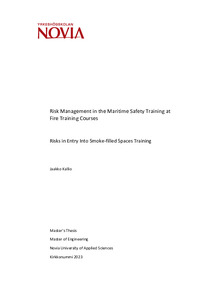Risk Management in the Maritime Safety Training at Fire Training Courses: Risks in Entry into Smoke-filled Spaces Training
Kallio, Jaakko (2023)
Kallio, Jaakko
2023
All rights reserved. This publication is copyrighted. You may download, display and print it for Your own personal use. Commercial use is prohibited.
Julkaisun pysyvä osoite on
https://urn.fi/URN:NBN:fi:amk-2023112932555
https://urn.fi/URN:NBN:fi:amk-2023112932555
Tiivistelmä
Seafarers are required to possess certain proficiencies, training and certificates to be allowed to work on international vessels. One of these requirements is the "[b]asic training in fire prevention and fire fighting". This requirement comprises the competences of "use of self-contained breathing apparatus" and "fight fire in smoke-filled spaces wearing self-contained breathing apparatus" (STCW Code).
The training in entry into smoke-filled spaces contains certain risks. The main aim of this thesis was to find out the risks involved in the training at the Maritime Safety Training Centre and figure out ways to negate these risks.
To achieve this goal, I started by researching the theory of smoke-diving. After the theoretical part, I conducted a questionnaire to find what risks other training institutions had detected. After gathering data, i used the ISO 31000 framework to perform a risk assessment of the training courses and created a risk management plan.
The training in entry into smoke-filled spaces contains certain risks. The main aim of this thesis was to find out the risks involved in the training at the Maritime Safety Training Centre and figure out ways to negate these risks.
To achieve this goal, I started by researching the theory of smoke-diving. After the theoretical part, I conducted a questionnaire to find what risks other training institutions had detected. After gathering data, i used the ISO 31000 framework to perform a risk assessment of the training courses and created a risk management plan.
